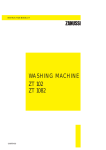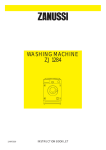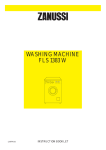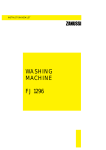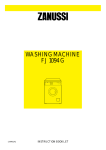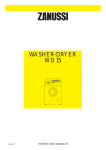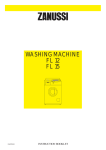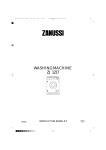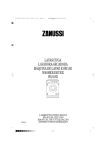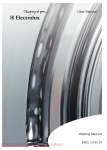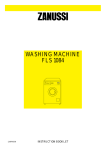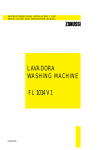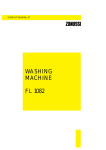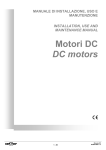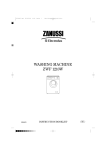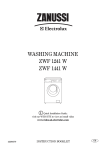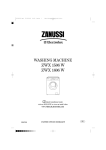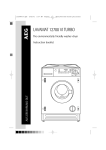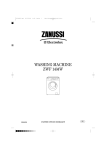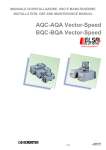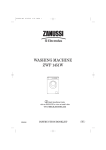Download Zanussi ZT 102 Instruction Manual
Transcript
INSTRUCTION BOOKLET WASHING MACHINE ZT 102 124978190 CONTENTS Important information . . . . . . . . . . . . . . . . . Page 3 Installation . . . . . . . . . . . . . . . . . . . . . Page 4 ■ Unpacking . . . . . . . . . . . . . . . . . . . . . . Page 4 ■ Positioning . . . . . . . . . . . . . . . . . . . . . . Page 5 ■ Water inlet . . . . . . . . . . . . . . . . . . . . . . Page 5 ■ Water drainage . . . . . . . . . . . . . . . . . . . . Page 6 ■ Levelling . . . . . . . . . . . . . . . . . . . . Page 6 ■ In the interest of the environment . . . . . . . . . . . . . . . . Page 7 ■ Electrical connection . . . . . . . . . . . . . . . . . . . Page 8 ■ Building-in . . . . . . . . . . . . . . . . . . . Page 9-10 Description of the appliance . . . . . . . . . . . . . . . Page 11 Technical specifications . . . . . . . . . . . . . . Page 11 . . . . . . . . . . . . . . Page 12 . . . . . . . Getting to know your machine ■ Control panel . . . . . . . . . . . . . . . . . . . . . Page 12 ■ Washing hints . . . . . . . . . . . . . . . . . . . . . Page 13 ■ Wash care symbols . . . . . . . . . . . . . . . . . . . Page 14 ■ Use of detergent and additives . . . . . . . . . . . . . . . . Page 15 ■ Programmes for cotton and linen . . . . . . . . . . . . . . . . Page 16 ■ Programmes for synthetics, delicates and wool . . . . . . . . . . . . Page 17 Using your machine . . . . . . . . . . . . . . . . . Page 18 ■ Washing 4.5 kg of white cotton at 95°C . . . . . . . . . . . . . . Page 18 ■ Washing 2 kg of synthetic fabrics at 50°C . . . . . . . . . . . . . Page 19 . . . . . . . . . . . . . Page 20 ■ Descaling, after each wash, external cleaning . . . . . . . . . . . . Page 20 ■ Cleaning the dispenser drawer, cleaning the drawer recess, the dangers of freezing . Page 20 ■ Cleaning the filter . . . . . . . . . . . . . . . . . . . . Page 21 ■ The water inlet filters . . . . . . . . . . . . . . . . . . . Page 21 . . . . . . . . . . . . . . . . . . Page 22 Zanussi guarantee conditions . . . . . . . . . . . . . . Page 23 Maintenance and cleaning Servicing 2 . . . . . . . IMPORTANT INFORMATION It is most important that this instruction book should be retained with the appliance for future reference. Should the appliance be sold or transferred to another owner, or should you move house and leave the appliance, always ensure that the book is supplied with the appliance in order that the new owner can get to know the functioning of the appliance and the relevant warnings. These warnings have been provided in the interest of safety. You MUST read them carefully before installing or using the appliance. ■ ■ ■ Istallation ■ ■ ■ ■ ■ ■ This appliance is heavy. Care should be taken when moving it. All packing and transit bolts must be removed before use. Serious damage can occur to the product and to property if this is not adhered to. See relevant section in instructions. Any plumbing work required to install this appliance should be carried out by a qualified plumber or competent person. Any electrical work required to install this appliance should be carried out by a qualified electrician or competent person. Care must be taken to ensure that the appliance does not stand on the electrical supply cable. If the machine is situated on a carpeted floor, please adjust the feet in order to allow air to circulate freely. ■ ■ Service/Repair ■ ■ ■ ■ ■ ■ Always unplug the appliance and turn off the water after use. Do not overload the appliance. See relevant section in instruction book. Only wash fabrics which are designed to be machine washed. If in doubt, consult the care label on the clothes. Before washing, ensure that all pockets are empty and buttons and zips are fastened. Avoid washing frayed or torn articles and treat stains such as paint, ink, rust, and grass before washing. Underwired bras must NOT be machine washed. Any objects such as coins, safety pins, nails, screws, stones or any other hard, sharp material can cause extensive damage and must not be placed into the machine. Under no circumstances should you attempt to repair the machine yourself. Repairs carried out by inexperienced persons may cause injury or serious malfunctioning. Contact your local Zanussi Service Centre. Always insist on genuine Zanussi spare parts. General Safety ■ Use Garments which have been in contact with volatile petroleum products should not be machine washed. If volatile cleaning fluids are used, care should be taken to ensure that the fluid is removed from the garment before placing in the machine. Wash small items such as socks, laces, washable belts etc in a washing bag or pillow case as it is possible for such items to slip down between the tub and the inner drum. Only use the advised quantities of fabric softener. Damage to the fabric can ensue if you over-fill. Refer to the manufacturer’s recommendations of quantities. As some duvets and eiderdowns should be washed in large commercial machines because of their bulk, please check with the manufacturer of the item before washing in a domestic machine. Leave the porthole door slightly ajar between washes to preserve the door seal. ■ ■ ■ It is dangerous to alter the specifications or attempt to modify this product in any way. This appliance is designed to be operated by adults. Children should not be allowed to tamper with the controls or play with the product. Pets and children have been known to climb into washing machines. Please check your drum before use. The glass door becomes very hot during the washing cycle. Keep children away from the vicinity of the appliance whilst it is in operation. Environment protection ■ ■ The materials used on this appliance marked with the symbol are recyclable. This means that they can be recycled by disposing of them properly in appropriate collection containers. When disposing of your old washing machine, the electric cable must be cut off and the door catch must be made unusable. 3 INSTALLATION Unpacking Before starting the machine up, the packing must be removed as follows. You are advised to keep all the packaging for reuse in case the machine is to be transported again. Using a spanner unscrew and remove the rear right bolt. Lay the machine gently on its back, making sure that the hoses are not squashed. P0255 Remove the polystyrene base and take off the bottom panel by unscrewing the central screw. Carefully slide out the right polythene bag. P0457 P0015 P0016 P0453 P0256 P0020 Repeat the operation for the left and central polythene bags. Re-fit the bottom panel using the 4 screws supplied with the door hinges (in the plastic bag) and the previously removed screw. Set the machine upright and remove the two remaining bolts from the back. Pull out the three plastic spacers from the holes into which the bolts were fitted. Plug the open holes with the plugs which you can find at the back of the appliance. 4 Positioning Your new washing machine has been designed to be permanently plumbed in to your home’s water supply and drainage system. However, if this is not possible, it may be connected to suitable existing taps with the drain hose discharging into a sink. The appliance has two inlet hoses, hot and cold, with female 3/4” BSP thread connectors. If this connection is not compatible with the plumbing of the existing installation, a variety of connectors are available from good hardware stores and plumbers merchants to suit most domestic plumbing. Any alteration to your existing plumbing must be carried out by a competent person, or qualified plumber. Water inlet The inlets on the back of the appliance are colour coded, blue for cold and red for hot. Before connecting the hoses be sure to fit the mesh filters supplied as per diagram. P0003 If only a cold water supply is available, connect the two hoses to a cold water outlet by means of a «Y» connection piece. Installation should comply with local water authority and building regulations’ requirements. The appliance must be given a separate cold water supply and not be connected to a mixer tap, a single outlet water heater or a booster pump. A minimum water pressure of 0.48 bar is required for safe operation of the appliance. If you cannot make the cold water connection direct from the rising mains, you may be able to operate the appliance from your cold water storage system. There should be a minimum distance of 5.02m 1 (16 /2 ft) between the appliance’s inlet and the bottom of the water storage tank. There will be sufficient pressure for the hot water supply, providing there is a minimun height of 2.74 metres (9 ft) between the bottom of the cold water storage tank and the bottom of the hot water cylinder. Set the hoses correctly by loosening the ring nuts. After positioning the inlet hoses, be sure to tighten the ring nuts again to prevent leaks. P0021 5 Water drainage This appliance is designed to be permanently plumbed into your home’s water supply and drainage system. Hook the end of the drain hose into a standpipe installed for the purpose. The standpipe must have an internal diameter of at least 40 mm (1 1/2") in order that there is an air gap between the drain hose and the standpipe. Make sure, that it is designed in such a way, that the end of the drain hose cannot be covered with water. The drain hose may be extended to a maximum of 4 metres. An additional drain hose and joining piece is available from your local service centre. The joining piece must have an internal diameter of 18 mm. Important Before connecting up the machine to new pipework or to pipework that has not been used for some time, run off a reasonable amount of water to flush out any debris that may have collected in the pipes. When discharging into a standpipe ensure that the end of the drain hose is neither too high nor too low. The top of the curve in the hose’s end should be no more than 90 cm (35.4”), and no less than 60cm (23.6”) above floor level. 3 pin Joining piece 40 mm inside dia min 600 mm min 900 mm max P0376 Levelling Level the washing machine by raising or lowering the feet. The feet may be tight to adjust as they incorporate a self locking nut, but the machine MUST be level. Any necessary adjustment can be made with a spanner. Accurate levelling prevents vibration, noise and displacement of the machine during operation. Some vibration is inevitable, especially if mounted on a wooden floor. Sprung wooden floors are particularly susceptible to vibration. For advice, consult a builder. If possible, always place the machine on a solid floor. Special conditions If the floor is carpeted with a deep-pile carpet or covered with crumbly or soft material, insert a rigid support base under the feet to prevent noise, vibration or displacement. The base should protrude a few centimetres beyond the edges of the machine. 6 P0850 Warning The machine should NOT be placed on deep pile carpeting. Note Please ensure that when the appliance is installed it is easily accessible for the engineer in the event of a breakdown. All plumbing and electrical work required to install this appliance must be carried out by competent persons or qualified plumbers or electricians. In the interest of the environment Washing machines and dishwashers should be connected to the FOUL drainage system, the water will then be taken to a sewage works for treatment before being discharged safely into a river. It is essential that these appliances are not connected to the surface water drainage system as this water is discharged directly into a river or stream and may cause pollution. If you require any further advice please contact your local authority drainage department. SHOWER SINK TOILET BATH WASHING MACHINE BIDET DISHWASHER RAINWATER 'RUN-OFF' FOUL DRAIN SURFACE WATER DRAINS & SEWERS UNTREATED DISCHARGE FOUL SEWERS SEWAGE TREATMENT WORKS TREATED DISCHARGE RIVER RIVER P0987 7 Electrical connections WARNING: THIS APPLIANCE MUST BE EARTHED. The manufacturer declines any liability should this safety measure not be observed. If the plug that is fitted to your appliance is not suitable for your socket outlet, it must be cut off and the appropriate plug fitted. Remove the fuse from the cut off plug. The cut off plug should then be disposed of to prevent the hazard of shocks in case it should be plugged into a 13 Amp socket in another part of your home. IMPORTANT The wires in the mains lead are coloured in accordance with the following code: - Earth Blue - Neutral Brown - Live If you fit your own plug, the colours of the wires in the mains lead of your appliance may not correspond with the markings identifying the terminals in your plug, proceed as follows: Connect the green and yellow (earth) wire to the terminal in the plug which is marked with the letter «E» or the earth symbol or coloured green and yellow. Connect the blue (neutral) wire to the terminal in the plug which is marked with the letter «N» or coloured black. Connect the brown (live) wire to the terminal in the plug which is marked with the letter «L» or coloured red. The plug moulded on to the lead incorporates a fuse. For replacement, use a 13 Amp BS1362 fuse. Only ASTA or BSI approved fuses should be used. The plug must not be used if the fuse cover/carrier is lost. The cover/carrier is indicated by the coloured insert at the base of the plug. A replacement cover/carrier must be obtained from your local Zanussi Service Centre, whose address is listed in the Customer Care Booklet which accompanies your instruction manual. 8 13 AMP FUSE 13 AMP Green and Yellow GREEN & YELLOW BROWN BLUE P0329 CORD CLAMP Building-in 600 596 600 min. 120 416 818 176,5 515 820 min This appliance has been designed to be built into the kitchen furniture. The recess should have the dimensions shown in picture A. 1 54 195 160 8 165 90 0 49 P0965 A Preparation and assembly of the door The machine is originally pre-arranged for the assembly of a door opening from right to left. In this case it is sufficient to screw in the hinges (1) and the counter-magnet (6) provided with the appliance, at the right level (Fig. B). 6 1 1 4 7 2 5 3 8 B B 35 Ø 14 prof. 16 -22 The distance (B) from upper edge of the door to the centre of the hole depends on the adjacent furniture's dimensions. ,5 22+1 The required dimensions are given in the picture C. The hinges will be fixed to the door by means of screws for wood (2-Fig. B) supplied with the appliance. C b) Hinges To mount the hinges it is necessary to drill two holes (dia. 35 mm, depth 14 mm) on the inner side of the door. The distance between the holes hobs fixing centres must be 416 mm. 23 P0982 416 a) Door The dimensions of the door should be: - width 595-598 mm - thickness 16-22 mm The height (C-Fig. C) depends on the height of the adjacent furniture's base. -598 595 P0422 C c) Mounting the door Fix the hinges (1) to the machine by means of the M5x8 screws (3-Fig. B). The hinges can be adjusted to compensate for possible uneven thickness of the door. To align the door perfectly it is necessary to loosen the screw (3-Fig. B), adjust the door and tighten the screw again. 9 d) Counter-magnet (6) The appliance is pre-arranged for a magnetic closure of the door. To enable a correct operation of this device, it is necessary to screw the countermagnet (6) (steel disk + rubber ring) into the inner side of the door. Its position must correspond to the magnet (4) on the appliance (see picture D). 6 4 8 D P0984 If the door has to be opened from left to right, invert the position of the plates (7), the magnet (4) and the rubber cap (5) (Fig. B and E). Mount the countermagnet (6) and the hinges (1) as previously described. E 6 4 Important: the plastic screw (8) should never be loosened (Fig. B and E). 5 7 1 3 8 P1014 10 2 i DESCRIPTION OF THE APPLIANCE 1 1 2 3 4 5 6 7 8 9 Detergent dispenser drawer Programme chart Mains-on light ON/OFF button Half load button Programme selector dial Door handle Drain filter Adjustable feet 3 45 6 2 7 8 1 Detergent dispenser drawer Symbols Prewash 9 Wash Fabric softener P0239 i TECHNICAL SPECIFICATIONS DIMENSIONS Height Width Depth POWER SUPPLY VOLTAGE TOTAL POWER ABSORBED 82 cm (32.3”) 60 cm (23.6”) 54 cm (21.5”) 220-240 V/50 Hz 2550 W (13A) WATER PRESSURE Minimum (hot) Minimum (cold) Maximum 0.35 bar (3.5 N/cm2) 0.48 bar (4.8 N/cm2) 07.6 bar (76 N/cm2) MAXIMUM RECOMMENDED LOAD Cotton, linen Synthetics Delicate fabrics Wool 4.5 kg (10 lbs) 2 kg (4.5 lbs) 2 kg (4.5 lbs) 1 kg (2.2 lbs) SPIN SPEED Maximum 1000 rpm This appliance complies with the following E.E.C. Directives: - 73/23 EEC of 19.2.73 (Low Voltage Directive) and subsequent modifications; - 89/336 EEC of 3.5.89 (Electromagnetic Compatibility Directive) and subsequent modifications. 11 GETTING TO KNOW YOUR MACHINE Control panel PROGRAMMES ON-OFF HALF LOAD ZT • 102 IMPORTANT : PLEASE READ THE INSTRUCTION BOOK BEFORE USING THIS APPLIANCE 1 2 1 Programme chart It will help you to select the suitable programme for your laundry. 2 Mains-on light This light illuminates when the machine starts working and goes out when the ON/OFF button is released. 3 ON/OFF button By depressing this button the machine starts operating. When depressing it again, the machine stops. The push button is provided with a child-proof safety lock. Move the small slider placed in the middle of the button downwards to lock the button in the «off» position. 4 Half load button Select this button to reduce water consumption on the rinse cycle when washing a smaller load of cottons or linens (maximum load size = 2.25 kg). 5 Programme selector dial With the programme selector dial you choose the desired washing programme. Depress the dial to pop it out and turn it clockwise. Before setting the dial to any position the machine must be switched off by depressing the ON/OFF button. 12 3 4 5 i Washing hints Do NOT overload the machine. Weigh the laundry the first few times you use the appliance. The average weights of the most common items are listed below as a guide: ■ Use a good quality detergent suitable for automatic washing machines. ■ Use the correct quantities of detergent. ■ For wool, use gentle detergent only in small quantities. ■ Bleach is very corrosive; it should be used with care and kept out of reach of children. ■ Some stains such as fruit, wine, grass, rust etc. are difficult to remove and should be treated before washing with specific products, which can be found in most household shops. In some cases it may help to soak the stain before washing with a special pre-soak product or biological detergent. ■ Only wool marked «Pure New Wool - washable, preshrunk» can be washed in the machine using the wool programme; other types of wool should be washed by hand or dry cleaned. ■ If you have used the machine to wash, rinse or spin only non-colour fast garments, there may be dye left in the sump. To ensure any subsequent wash is not contaminated with the dye, select and carry out a rinse and spin programme, without any garments, to ensure that any dye is removed from the sump. ■ Once you have finished using the machine, you are advised to unplug it and turn off the water taps. 1000g = 1 kg Sheet 700-1000 g Pillow case 100-200 g Tablecloth 400-500 g Serviette 50-100 g Tea towel 70-120 g Linen hand towel 100-150 g Towelling hand towel 150-250 g Towelling bath towel 700-1000 g Bath robe 1000-1500 g Man’s shirt 200-300 g Apron 150-200 g ■ Load the laundry loosely alternating large items with small ones. ■ Sort the laundry according to the type of fabric, colour-fastness and how dirty it is. ■ Avoid washing unhemmed or torn items as they may unravel. ■ Before washing, empty all pockets of small objects which may have been left inside (coins, keys, screws etc). as these could damage the drain pump. ■ When washing curtains, remove the hooks. ■ Close poppers and zips and fasten loose buttons. ■ It is essential to wash new coloured items separately when washing for the first time. ■ When washing fabrics requiring different wash temperatures together, always select the lowest temperature. ■ White items should not be washed with coloured items. ■ Very small items (handkerchiefs, ribbons, socks etc) should be washed in a washing bag or a pillow case. 13 i Wash Care Symbols Wash care labels inside garments recommend how to launder your clothes with the best results. The care labelling code is in line with care labelling used in the rest of Europe. The symbols used make it easy to select the correct programme on your washing machine. WASHING SYMBOL WASH ACTION 95 Normal (Maximum) White Cotton or Linen without Special Finishes 60 Normal (Maximum) Cotton, Linen or Viscose without Special Finishes Colourfast at 60°C. 50 Reduced (Medium) Nylon, Polyester/Cotton, Viscose with Special Finishes, Cotton/Acrylic Mix. 40 Normal (Maximum) Cotton, Linen or Viscose Colourfast at 40°C but not 60°C. 40 Reduced (Medium) Acrylics, Acetate, Triacetate, Wool mixes, Polyester/wool blends. 40 Much Reduced (Minimum) Hand wash only FABRIC Wool, wool mixtures, Silks Do not machine wash BLEACHING Chlorine bleach may be used IRONING Hot iron Cotten, Linen, Viscose Warm iron Polyester mixtures, Wool Cool iron Acrylic, Nylon, Polyester DRY CLEANING May be dry cleaned. Other letters and/or a bar beneath the circle will indicate the required process to the dry cleaner. TUMBLE DRYING May be tumble dried with high heat setting with low heat setting X i A cross through any symbol means «DO NOT» Important Notes For best results, always use the dispenser drawer for dispensing detergents and liquid additives. Once the dispenser has been filled, close it by pushing it in gently. This is particularly important if you are using fabric conditioner to avoid the 14 conditioner entering the machine prematurely. When using liquid detergent and a prewash programme, place the detergent into the correct compartment in the dispenser drawer, after the prewash has finished. Use of detergent and additives Which detergent? And in which form? To ensure you obtain the best wash results from your appliance, it is important to use the right detergent in your everyday wash, and only detergents recommended for use in automatic machines. To maintain the appearance of your clothes and household textiles and to make them last longer you should use different types of detergent for different washes, whether for whites, colours or delicates. Not only are there different types of detergent, but they are also available in different forms. Whether you chose a powder or liquid in traditional or compact form is to own personal choice. Whites Liquid can be placed in the main wash compartment of the detergent drawer marked with the symbol , start the machine immediately upon placing the detergent in the dispenser drawer. Alternatively the detergent is measured into the specially designed dosing device* which should be placed on top of the laundry, and at the back of the machine drum. We recommend the Ariel product range which is biological and designed to provide excellent cleaning and stain removal even at low temperatures. Non Biological If you prefer to use a non biological detergent, which does not contain enzymes we recommend Fairy. Fairy provides good cleaning and stain removal. Coloureds For coloured items you should use a detergent which is designed to clean while maintaining the original colour. Ariel Color does not contain bleach and therefore helps to preserve colours. Traditional Powders Pour the powder directly into the dispenser drawer. Do not sprinkle powder onto clothes in the machine drum. Traditional Liquids Compact Powders and Liquids Compact detergents (or concentrates as they are also known) are available in liquid or powder form, and generally require a smaller dosage. Follow the manufacturer’s instructions to ensure the most economical usage. Pour the detergent directly into the dispenser drawer, or alternatively measure the detergent into the specially designed dosing device* which should be placed on top of the laundry, and at the back of the machine drum. * If you use a dosing device in a washer dryer, please ensure the dosing device/ball is removed before carrying out a drying programme. Delicate Items Fabric Conditioners When washing delicates such as woollens, you should use a product which is specially designed to care for fine fabrics. Dreft Automatic is suitable for woollens and other delicates. These are ideal for improving “softness”, and also reduce static cling on synthetics and make ironing easier. They are available in two types: Laundry Bleach For additional stain removal you may wish to use a product such as Ace Gentle Bleach which is used in addition to your chosen detergent. Ace is suitable for all washable fabrics including silks, woollens and coloureds. For example Lenor liquid fabric softener, for use in the washing machine/washer dryer. The liquid fabric softener should be poured into the compartment marked with the symbol . Follow the manufacturer’s dosage instructions and never exceed the MAX level. Bounce conditioning sheets for use in a tumble dryer. We recommend the conditioning sheets are pinned (using a safety pin) to an article of laundry and placed in the tumble dryer. 15 Programmes for cotton and linen Recommended load: max. 4.5 kg (10 lb) Degree of soil Programme dial position/ Temperature Description BOILWASH WITH PREWASH Heavy A 95° Prewash at 40°C Wash at 95 °C 4 rinses Spin BOILWASH WITHOUT PREWASH Normal B 95° Wash at 95 °C 4 rinses Spin FAST COLOUREDS Normal C (•) 60° Wash at 60 °C 4 rinses Spin NON FAST COLOUREDS Normal D 40° Wash at 40 °C 4 rinses Spin Programmes LONG SPIN 1000 F Possible option Spin at 1000 rpm Water filling: 30°/40° programmes: cold water filling Water filling: 50°/60° programmes: hot and cold filling Water filling: 50°/95° programmes: hot filling only (•) This 60°C programme is the reference programme for the Energy Label according to the article 2, paragraph 1 of the EEC Directive 92/75. 16 Programmes for synthetics, delicates and wool Recommended load: max. 2 kg (4.5 lb); wool max. 1 kg (2.2 lb) Degree of soil SYNTHETICS Normal G 50° Wash at 50 °C 3 rinses Stop with water left in the tub Normal H 40° Wash at 40 °C 3 rinses Stop with water left in the tub Normal J 40° Wash at 40 °C 3 rinses Stop with water left in the tub Light K 30° Wash at 30 °C 3 rinses Stop with water left in the tub L 3 rinses, with fabric softener, if required Stop with water left in the tub FRESHEN UP M 1 rinse, with fabric softener, if required Stop with water left in the tub SHORT SPIN N Draining of water and short spin at 650 rpm DRAIN P Draining of water WOOL DELICATES 30° Programme dial position / Temperature Programmes WORN ONCE HAND RINSES Description Possible option Important! At the end of the last rinse, the washing machine stops without draining the water so that the garments do not crease. To drain the water, select programme N (short spin) or P (draining). 17 USING YOUR MACHINE Washing 4.5 kg of white cotton at 95°C Suppose you have 4.5 kg of normally dirty laundry to wash. It is white cotton and is suitable for high temperature washing. 1. Load the laundry Open the door by pulling the catch outward. Load the items one at a time and close the door. 2. Measure out the detergent Pull out the detergent dispenser drawer from the control panel. Measure out the amount of detergent required and pour into the main wash compartment. If you wish to carry out a programme with prewash, pour the amount of detergent required into the «prewash» compartment. 3. Add the fabric softener if required P0005 P0006 Pour the fabric softener, if required, into the compartment marked . Do not exceed the MAX level and then close the drawer gently. 4. Select the required option Depress HALF LOAD if desired. 5. Select the required wash programme Turn the programme selector dial clockwise to the required programme. ON/OFF A 6. Start the machine Before starting up the machine check that: ■ the appliance is plugged in ■ the water supply taps are turned on ■ the drain hose is correctly and securely positioned ■ the door and the detergent dispenser drawer are closed. Depress the ON/OFF button: the mains-on light illuminates and the machine starts operating. 7. At the end of the programme The machine stops automatically. The door is controlled by a safety device which releases 2 minutes after the end of the programme. 18 P0429 P0726 Switch the machine off by depressing the ON/OFF button again. The mains-on light goes out. When the programme has finished you are advised to unplug the appliance and turn off the water taps. Washing 2 kg of synthetic fabrics at 50°C Suppose you have 2 kg of synthetic fabrics to wash. They are rather delicate fabrics and should not be washed at a high temperature. 1. Load the laundry Open the door by pulling the catch outward. Load the items one at a time and close the door. 2. Measure out the detergent Pull out the detergent dispenser drawer from the control panel. Measure out the amount of detergent required and pour into the main wash compartment. 3. Add the fabric softener if required Pour the fabric softener, if required, into the compartment marked . Do not exceed the MAX level and then close the drawer gently. P0005 P0006 4. Select the required wash programme Turn the programme selector dial clockwise to the required programme. ON/OFF 5. Start the machine Before starting up the machine check that: ■ the appliance is plugged in ■ the water supply taps are turned on ■ the drain hose is correctly and securely positioned ■ the door and the detergent dispenser drawer are closed. Depress the ON/OFF button: the mains-on light illuminates and the machine starts operating. G P0673 P0726 6. At the end of the programme The machine stops automatically. The machine stops after the last rinse with the water left in the wash tub, to prevent the fabric from creasing. To drain the water select programme N or P. The door is controlled by a safety device which releases 2 minutes after the end of the programme. Switch the machine off by depressing the ON/OFF button again. The mains-on light goes out. When the programme has finished you are advised to unplug the appliance and turn off the water taps. 19 MAINTENANCE AND CLEANING Before any maintenance or cleaning is carried out you must DISCONNECT the appliance from the electricity supply. Descaling The water we normally use contains lime. It is a good idea to periodically use a water softening powder in the machine. Do this separately from any laundry washing, and according to the softening powder manufacturer's instructions. This will help to prevent the formation of lime deposits. After each wash Leave the door open for a while. This helps to prevent mould and stagnant smells forming inside the appliance. Keeping the door open after a wash will also help to preserve the door seal. External cleaning Clean the exterior cabinet of the appliance with soap and water only, and then dry thoroughly. Cleaning the dispenser drawer From time to time the washing powder and additive dispenser drawer should be cleaned. Remove the drawer by pressing the catch downwards and by pulling it out. Flush it out under a tap, to remove any traces of accumulated powder. Cleaning the drawer recess Having removed the drawer, use a small brush to clean the recess, ensuring that all washing powder residue is removed from the upper and lower part of the recess. Replace the drawer and run the rinse programme for a few minutes without any clothes in the drum. P0010 P0009 P0038 The dangers of freezing If the machine is exposed to temperatures below 0°C, certain precautions should be taken. ■ Turn off the water taps. ■ Unscrew the inlet hoses. ■ Unhook the drain hose from the rear support and position the end of this hose and that of the inlet hoses in a bowl. Run the draining programme until the selector dial is in the “Stop” position. 20 ■ ■ ■ Disconnect the appliance. Screw the inlet hoses and reposition the drain hose. When you intend to start the machine up again, make sure that the room temperature is above 0°C. Cleaning the filter The water drain filter A clean filter is important for the correct functioning of the machine, and should therefore be cleaned after every washing programme. Place a container underneath to catch any spillage. If the filter is blocked and the machine is unable to drain you will need to drain the water manually from the machine at this stage. To do this, unhook the drain hose from the standpipe or sink and hold the end of the hose over a bowl on the floor. The water should drain by gravity into the bowl. When the bowl is full, hook the hose back up and empty the bowl. Repeat the procedure until water stops flowing out. Unscrew and remove the filter. P0037 P0039 Clean carefully under a fast running tap. P0040 Warning When the appliance is in use and depending on the programme selected there can be hot water in the filter. Never remove the filter during a wash cycle, always wait until the appliance has finished the cycle, and is empty. When replacing the filter, ensure it is securely retight-ened so as to stop leaks and young children being able to remove it. The water inlet filters If your water is very hard or contains traces of lime deposit, the water inlet filters may become clogged. It is therefore a good idea to clean them from time to time. Turn off the water taps. Unscrew the water inlet hoses. Remove and clean the filters using a hard bristle brush. Replace the filters and tighten up the inlet hoses. P0041 21 SERVICING Before contacting your local Zanussi Service Centre, please make the following checks: The machine does not start up ■ ■ ■ ■ The ON/OFF button has not been depressed The door is not closed properly No water is entering the machine (see: the machine does not fill) The selector dial is not correctly positioned The machine does not fill ■ ■ ■ ■ ■ ■ The water tap is not turned on The water supply has been disconnected The inlet hose is kinked The water pressure is too low The water inlet filter is clogged The door is not closed properly The machine empties as it fills ■ ■ ■ The end of the drain hose is too low The end of the drain hose is submerged in water Drain pipe has no vent-hole The machine does not drain or spin ■ ■ ■ ■ ■ ■ You have selected a gentle wash cycle with the RINSE HOLD option The drain filter is clogged The drain hose is kinked The drainage system pipes are blocked The drain hose extension is incorrect The wash load is unbalanced. Redistribute the load inside the drum to allow the machine to spin. ■ ■ ■ ■ The machine is not level The machine is in contact with the wall or furniture The washing load is badly distributed The machine is overloaded The door does not open ■ ■ The safety device has locked it Water in the tub: the door cannot be opened if water is present in the tub If after the above checks, there is still a fault, call your local Zanussi Service Force Centre. In-guarantee customers should ensure that the above checks have been made as the engineer will make a charge if the fault is not a mechanical or electrical breakdown. Please note that proof of purchase is required for any in-guarantee service calls. Service & Spare Parts If you require an engineer or wish to purchase spare parts contact your local Zanussi Service Force Centre by telephoning: 0990 929929 Your telephone call will be routed to the Service Centre covering your post code area. Further information can be found in the accompanying customer care booklet and also in your telephone directory under “Z”. When you call the Service Force Centre please make sure you give the model and serial number of the appliance. This information can be found on the rating plate (see picture) or on the guarantee card. Mod. .......... Ser. The machine leaks or overflows ■ ■ ■ ■ ■ ■ Too much detergent Unsuitable detergent The inlet hose is loose The detergent dispenser drawer or recess is clogged The end of the drain hose is not securely positioned The drainage system pipes are blocked Mod. .......... Prod. No. ........... P0042 Ser. No. ......... Customer Care For general enquiries concerning your Zanussi appliance or for further information on Zanussi products, please contact our Customer Care Department by letter or telephone as follows: Customer Care Department The machine vibrates or is noisy ■ 22 The internal packing and transit bolts have not been removed Zanussi Zanussi House Hambridge Road - Newbury - Berkshire - RG14 5EP Tel 01635 521313 PEACE OF MIND FOR TWENTY-FOUR MONTHS Standard guarantee conditions European guarantee We, Zanussi Limited undertake that if, within 24 months of the date of the purchase, this Zanussi appliance or any part thereof is proved to be defective by reason only of faulty workmanship or materials, we will, at our option, repair or replace the same FREE OF ANY CHARGE for labour, materials or carriage on condition that: ■ The appliance has been correctly installed and used only on the electricity supply stated on the rating plate. ■ The appliance has been used for normal domestic purposes only, and in accordance with the manufacturer’s instructions. ■ The appliance has not been serviced, maintained, repaired, taken apart or tampered with, by any person not authorised by us. All service work under this guarantee must be undertaken by a Zanussi Service Force Centre. Any appliance or defective part replaced shall become the Company’s property. This guarantee is in addition to your statutory and other legal rights. Home visits are made between 8.30am and 5.30pm Monday to Friday. Visits may be available outside these hours in which case a premium will be charged. If you should move to another country within Europe then your guarantee moves with you to your new home subject to the following qualifications: ■ The guarantee starts from the date you first purchased your product. ■ The guarantee is for the same period and to the same extent for labour and parts as exists in the new country of use for this brand or range of products. ■ The guarantee relates to you and cannot be transferred to another user. ■ Your new home is within the European Community (EC) or European Free Trade Area. ■ The product is installed and used in accordance with our instructions and is only used domestically, i.e. a normal household. ■ The product is installed taking into account regulations in your new country. ■ This guarantee does not cover freestanding appliances which have a 12 months guarantee. Exclusions This guarantee does not cover: ■ Damage or calls resulting from transportation, improper use or neglect, the replacement of any light bulbs or removable parts of glass or plastic. ■ Costs incurred for calls to put right an appliance which is improperly installed or calls to appliances outside the United Kingdom. ■ Appliances found to be in use within a commercial environment, plus those which are subject to rental agreements. ■ Products of Zanussi manufacture which are NOT marketed by Zanussi Ltd. Before you move please contact your nearest Customer Care Centre, listed below, to give them details of your new home. They will then ensure that the local Service Organisation is aware of your move and able to look after you and your appliances. France Senlis +33 (0)344 62 29 99 Germany Nurnberg +49 (0)911 323 2600 Italy Pordenone +39 (0)1678 47053 Sweden Stockholm +46 (0)8 738 79 50 UK Newbury +44 (0)1635 521313 23 Z
























